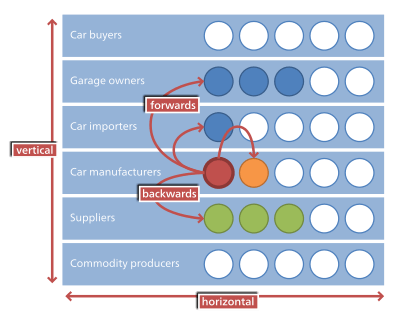Horizontal integration

Horizontal integration is the process of a company increasing production of goods or services at the same part of the supply chain. A company may do this via internal expansion, acquisition or merger.[1][2][3]
The process can lead to monopoly if a company captures the vast majority of the market for that product or service.[3]
Horizontal integration is orthogonal to vertical integration, where companies integrate multiple stages of production of a small number of production units.
Horizontal alliance
Horizontal integration is related to horizontal alliance (also known as horizontal cooperation). However, in the case of a horizontal alliance, the partnering companies set up a contract, but remain independent. For example, Raue & Wieland (2015) describe the example of legally independent logistics service providers who cooperate.[4] Such an alliance relates to coopetition.
Aspects of horizontal integration
Benefits of horizontal integration to both the firm and society may include economies of scale and economies of scope. For the firm, horizontal integration may provide a strengthened presence in the reference market. It may also allow the horizontally integrated firm to engage in monopoly pricing, which is disadvantageous to society as a whole and which may cause regulators to ban or constrain horizontal integration.[5]
Media terms
Media critics, such as Robert W. McChesney, have noted that the current trend within the entertainment industry has been toward the increased concentration of media ownership into the hands of a smaller number of transmedia and transnational conglomerates.[6] Media is seen to amass in centre where wealthy individuals have the ability to purchase such ventures (e.g. Rupert Murdoch).
Horizontal integration, that is the consolidation of holdings across multiple industries, has displaced the old vertical integration of the Hollywood studios. The idea of owning many media outlets, which run almost the same content, is considered to be very productive, since it requires only minor changes of format and information to use in multiple media forms. For example, within a conglomerate, the content used in broadcasting television would be used in broadcasting radio as well, or the content used in hard copy of the newspaper would also be used in online newspaper website.
What emerged are new strategies of content development and distribution designed to increase the “synergy’ between the different divisions of the same company. Studios seek content that can move fluidly across media channels.[7]
Examples
An example of horizontal integration in the food industry was the Heinz and Kraft Foods merger. On March 25, 2015, Heinz and Kraft merged into one company.[8][9] Both produce processed food for the consumer market.
Sysco had planned to acquire US Foods before a federal ruling against the deal.[10] lt would have been horizontal integration, as both distribute food to restaurants, healthcare, and educational facilities
References
- ↑ "Horizontal Integration Definition". economicshelp.org. Retrieved 5 February 2016.
- ↑ "Definition of Horizontal Integration in a Supply Chain". smallbusiness.chron.com. Retrieved 5 February 2016.
- 1 2 "horizontal integration". businessdictionary.com. Retrieved 5 February 2016.
- ↑ Raue, J.S. & Wieland, A. (2015), The interplay of different types of governance in horizontal cooperations: a view on logistics service providers. The International Journal of Logistics Management, Vol. 26, No. 2.
- ↑ "Horizontal Integration - What It Really Means For Marketing - Ardor Media Factory". Ardor Media Factory. Retrieved 2016-02-19.
- ↑ Thorburn, David and Jenkins, Henry (eds)(2002) Rethinking Media Change, MIT Press, Cambridge, Massachusetts, pp.283.
- ↑ Thorburn, David and Jenkins, Henry (eds)(2003) Rethinking Media Change, MIT Press, Cambridge, Massachusetts, pp.284.
- ↑ http://www.nytimes.com/2015/03/26/business/dealbook/kraft-and-heinz-to-merge.html?_r=0
- ↑ http://time.com/3770785/heinz-kraft-merger/
- ↑ "Sysco Ends Plans to Merge With US Foods". WSJ. Retrieved 5 February 2016.
See also
- Horizontal market
- Vertical integration
- Economies of scale
- List of management topics
- List of marketing topics
- List of economics topics
- Monopoly
- Strategic management
- Target market